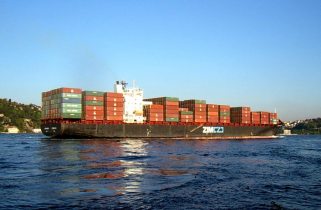Though things change and change fast in the international shipping business, you can have a firm grasp on shipping basics. Below is a clear, current, and concise understanding of the how, where, and what of ocean freight international shipping.
Here are the questions we’ll cover:
-
How do things get shipped internationally?
-
Where is the most international shipping taking place?
-
What is the current economic state of international shipping?
Think of this as international shipping 101 with an emphasis on how things look now after the semi-recent international economic down slump.
1. How do things get shipped internationally?
First, we deal with the “how”. How do things get shipped internationally? This brings us to one of the most important terms in the business, the basic unit of global economy, the TEU: twenty-foot equivalent unit.
Image: Emre Dogan | Public Domain
 Container shipping is the most common “how” of international shipping. Your import or export goods are packed into a shipping container, loaded onto a carrier ship, and brought through customs at your destination country.
Container shipping is the most common “how” of international shipping. Your import or export goods are packed into a shipping container, loaded onto a carrier ship, and brought through customs at your destination country.
Your average shipping container used to enclose twenty feet. Now, like many things in the international shipping industry, the average is bigger, in this case, two times bigger. The new average sized shipping container is approximately 40 feet long.
You’ll often see it written as FEU or sometimes 2 TEUs.
Just because FEU has taken over as the most popular shipping container size does not mean 20 foot containers are not still used.
Some of the latest shipping containers can even float (in case they are lost overboard) and have built in technology that allows their owners to identify where they are and what is within them at all times.
Recent advances in ship design have resulted in ships with even larger carrying capacities. It means more shipping containers on a voyage than was ever possible in the past.
Next year, Maersk (the biggest international shipping company in the world) will launch its much-talked about (and blogged-about) EEE class ship. At 1,312 ft. it is longer than previous ships by a few feet, but what really distinguishes the EEE class ship is its design wizardry that enables the ship to carry 2,500 more containers (18,000 total) than the largest ships on the seas today.
With increasingly automated ports in many developed nations making the loading and unloading of shipping containers swifter and thus more profitable, shipping internationally has never been more efficient.
2. Where is the most international shipping taking place?
Next, we look at the where. Where do all these ships of cargo containers go and what routes do they take to get there? Specifically, where is the most international shipping taking place?
China to the West Coast of the US is the most trafficked sea route. Export from Asian cities accounts for 43% of all maritime trade. The Northwest and Northeast passages, now open during summer months thanks to climate changes, offer shorter (and therefore faster and cheaper) northern routes to and from Asian ports.
Universal Cargo Management imports and exports throughout the world. However, exports and imports to and from China are consistently our most numerous and frequent.
Get a rate quote now on shipping to or from China.
3. What is the current economic state of international shipping?
Finally, what is the state of the economics of international shipping? There is both good and bad here.
A marked increase in over-seas trade has been the trend for many years, aided by technological advancements such as some of the things mentioned above.
Overall volume was up 6.2% in 2011. But such increases had an unexpected backlash for the companies who operate the cargo vessels. Carriers added ships, often larger ships, to their active fleets and added more shipping routes they operated.
All these additions created overcapacity–more ship space for shipping containers than cargo that was being shipped internationally.
So called “rate wars” caused by overcapacity triggered steep declines in shipping rates and consequentially major financial losses for international container ship operators. The major players in overseas shipping like Maersk, MSC, and CMA CGM Group are only very slowly recovering.
Port operators continued to make neat profits despite the economic hit taken by ship operators, but businesses that buy and sell international goods are the real winners.
Significant decrease in the cost of shipping in recent years, even despite the freight rate increases the carriers have worked hard at putting into place here in 2012, means the real winners are those who make their money by buying and selling imported goods.
It costs just $6.80 to ship 100 lbs. of coffee for example, and only $0.80 to move a barrel of oil. These numbers relate to big companies shipping in bulk. But still, these lowered costs mean it is generally a good time to be in the business of international trade.
Universal Cargo Management, as a friend to your company, is here to help you succeed in international trade. Read our blogs for the latest in international shipping information and contact us for free freight rates for your imports and exports around the world.
